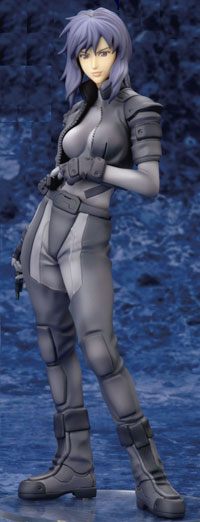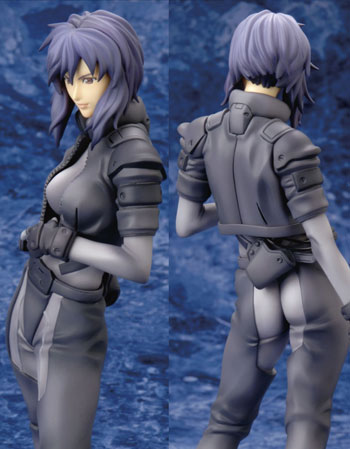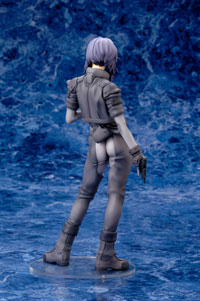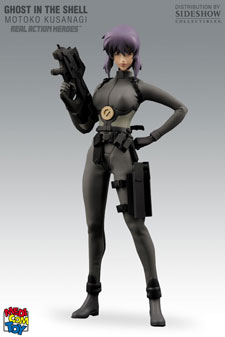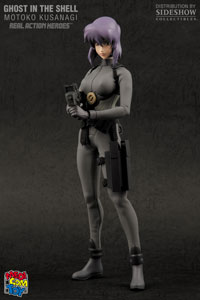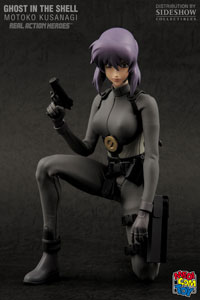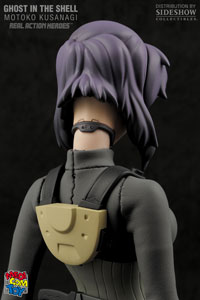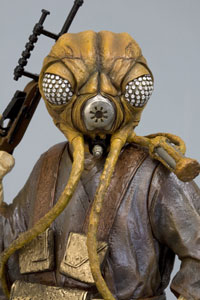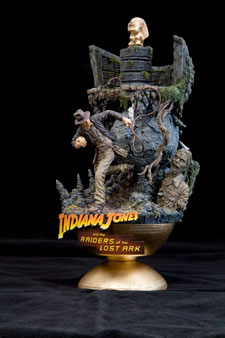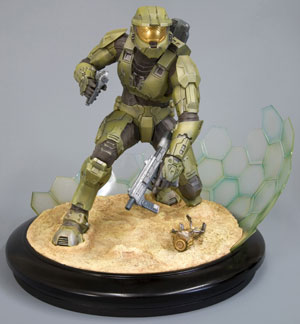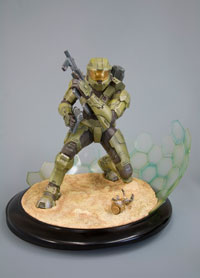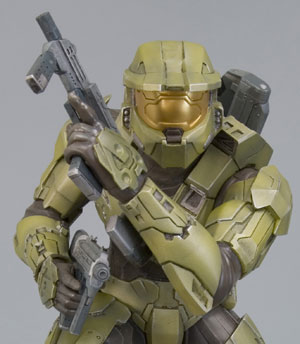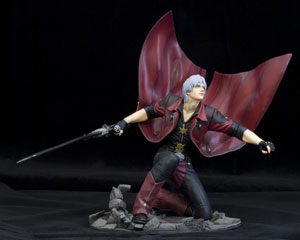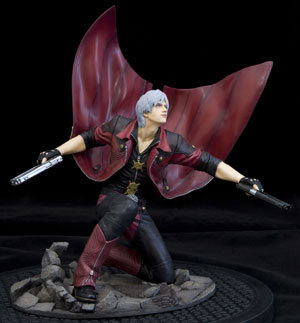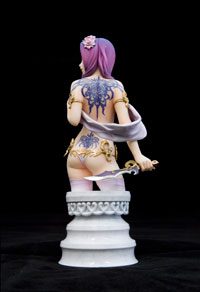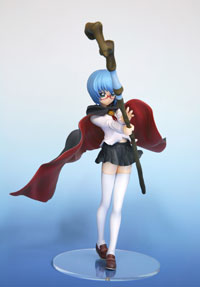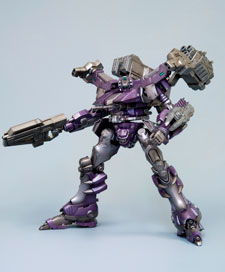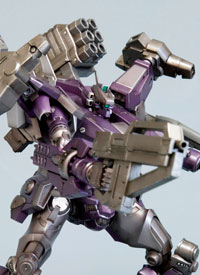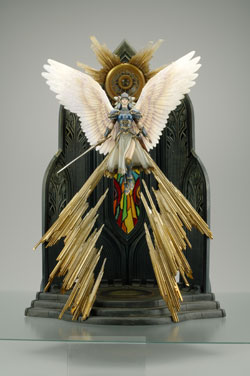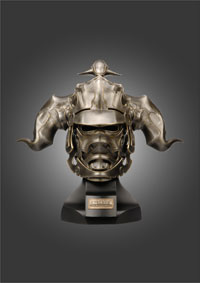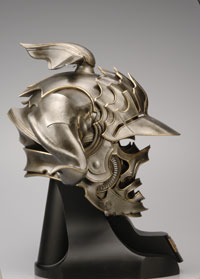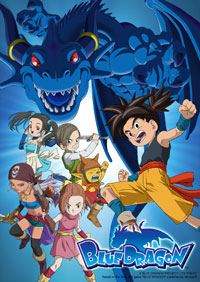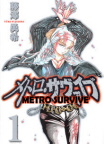 Logo handmade by Bannister
Column by Scott Green
Logo handmade by Bannister
Column by Scott Green
Maybe from a design perspective, Blood isn't such a strange item of intellectual property. The core proposition is like that of a video game in that it's offering a clearly defined role to work with, like female Indiana Jones or Snake Plissken-esque soldier. To begin with, it is called "Blood, and even its creators are quick to reduce the concept to "a girl in sailor suit fighting monsters with a Japanese sword." A vampire who looks like a uniform clad teenage girl kills more monstrous vampire creatures at the behest of a shadowy organization. It's when you start surveying the particulars, especially its history, that Blood starts looking intriguingly bizarre. In the Blood: The Last Vampire titles, this Saya character is a cold, predatory monster beneath her fair exterior. Even if her origin (or across the spectrum of works, origins) is spelled out, there's an ambiguity to this mournful, but not entirely sympathetic figure. In the Blood+ titles, she's a conventional schoolgirl who does not remember her savage past. She's almost a gothic superhero: protected through the tragedies of the past so that she can in turn protect the future. Many of the early entries in the franchise are more interesting as a function of who worked on them and what they attempted. Given the longevity and breaks in this history Blood seems to have endured as much on hype and artist reputation as it did on merit before cleaning itself up for the mass market in the evolution between the original Blood: The Last Vampire phase and the more recent second incarnation, Blood+ Production I.G, the studio behind all of the Ghost in the Shell anime, Jin-Roh: The Wolf Brigade, and the anime segment of Kill Bill has always been trail blazing in how they push both artistic and commercial agendas. Even when the results flop in one respect or both, the effort and the idea is compelling. To witness an idiosyncratic exercise in testing technique then, reaching out with a full expression, rent their paired Edo era works: the OVA Kai Doh Maru, which is enthralling for its raw, unfinished qualities, then their almost as experimental TV psuedo-follow-up Otogi Zoshi. When they released Blood: The Last Vampire in 2000, production problems were evident. Though it boasted a pioneering mix of 2d and 3d digital animation, the planned three episode OVA collapsed into a 45 minute, jaggedly paced "feature." Now that many people follow video game development, the term "tech demo" is often applied to short, boundary pushing, but feature-light releases. An aspect of Blood: The Last Vampire was to demonstrate Production I.G's digital animation techniques to the world, but rather than call it a "tech demo," call it a productized initiative. They were trying to showcase what they were capable of, but they were also marketing Blood: The Last Vampire. Mamuro Oshii, director of Ghost in the Shell and Ghost in the Shell: Innocence, played the role of godfather to the production. He fostered the work of Production I.G's team of young creators label Team Oshii, and one of the ideas that this mini-think tank produced was the high concept for Blood. After guiding the movie, Oshii entered into the franchise himself, penning a trilogy of novels, one of which is available in English. Production I.G would then go onto work with Sugar and Rockets to developed two PlayStation 2 graphical adventure games: Blood: The Last Vampire (Joukan/First Part) and Blood: The Last Vampire (Gekan/Last Part), later combined as Yarudora Series Vol. 5: Blood: The Last Vampire for the PSP. In 2001, as if to further demonstrate their strange stewardship of the IP, Production I.G lent Blood over to manga artist Benkyo Tamaoki for a work that has been released in North America as Blood: The Last Vampire 2002. For a franchise that is subject to international aspirations, it is a bit unexpected to attach a manga artist known for adult work with underground sensibilities. After a few years of dormancy, Production I.G return to the franchise in 2005 with the Blood+ 50 episode TV series. This time, they ironed out the rough edges and went full out. The anime was accompanied by two series of light novels. One, four volume work, written by Ryo Ikehata with illustrations by Chizu Hashii that fleshed out the anime. A second, Blood+ Russian Rose, written by Karino Chogatsu and illustrated by Ryo Takagi expanded on a flashback to Saya's mission into Russia during the time leading up to the Bolshevik Revolution. Three Blood+ manga were serialized across three different publications: Blood+, an adaptation of the anime by Asuka Katsura ran for five-volumes in Beans Ace Magazine, Blood+ Adagio, by Kumiko Suekane ran for two volumes in Monthly Shonen Ace and covered the Russian chapter, and Blood+ Yako Joshi/City of the Night Walkers, was a one volume work by Hirotaka Kisaragi, running in Asuka Ciel, which was set in Shanghai and told a yaoi (homosexual male romance for a female audience) version of the story. Predictably, games were to follow. Two were released for the Playstation 2. Blood+: Soyoku no Battle Rondo was Sony Entertainment’s action shooter set in the events between episodes 32 and 33 of the anime. Blood+: One Night Kiss was a Goichi Suda (Killer 7, No More Heroes) action shooter from Bandai Namco and Grasshopper Manufacture in August, 2006. This latter game featured an original playable character in addition to Saya. For completeness sake, NewType released a BLOOD + Encyclopedia fanbook. In 2006, Bill Kong announced production of a live action adaptation of Blood: the Last Vampire, and the production is now going forward, directed by Ronny Yu (Fearless) with Jun Ji-Hyun (My Sassy Girl) as Saya. This story is to be set in American occupied Tokyo in the time following World War II.
Blood: The Last Vampire
AICN Anime aims to look at all of the Blood releases that are available in North America. This column will work through Blood: The Last Vampire, while the next one hits Blood+ Presumably, Blood+ has a series bible. There has to be a firm timeline for its Saya and rules by which she and her world function. Blood: The Last Vampire seems to be operating off a sheet of suggestions recorded from a brainstorming session. There's a consistent actor and a consistent proposition: Saya enters a school to immediately undertake an extermination mission. Though the characters origin differs from one to another, the key differences between entries is the purpose to which Saya as a plot device is applied. They could be different aspects of the same story or entirely different stories in the same tradition. It's as if the Man with No Name cycle was directed by three different directors with three different agendas, with Clint Eastwood, his character's locale and his character's demeanor serving as the consistent canvas.

Blood: The Last Vampire (Anime Movie) Released by Manga Entertainment
There was plenty of hype leading into Blood's 2001 North American release. The anime boom had a full head of steam. Manga Entertainment was experimenting with free online screening through Sputnik7 on the day of the movie's DVD and New York/LA theatrical release. James Cameron was quoted as saying that its techniques represented the "future of digital animation." And the reception was "...that's it?" To this day, the external factors around the movie are more interesting than the feature itself. In an unscientific experiment, I recently showed this movie to a cold audience who did not know the movie's significance or reputation. While they appreciated its approach to representing motion, ultimately, their reaction was not categorically different from the launch day viewers. Blood: The Last Vampire is shorter than it should be and structurally messy. With 45 minutes to work with, it could have been a well formed set piece. Or, if the intension was to depict a cluster ____ situation, more could have been done to reflect frenzied confusion. Instead, the movie appears as much as an onscreen echo of an exercise in problem solving and experimentation as it does a satisfying narrative. To its detriment, the movie attempts to build around the three acts of a feature, without the time or transitions to facilitate the model. It's as if the producers labored to refine the climax of each act without oversight into how to link the phases. These aren't problems of logic. No one is going to have trouble following the story. If there is a gun fired/sword drawn in one scene, that weapon is introduced in a preceding one. The issues are more the consequence of how the movie engages its audience. Even if it is short, at a given point, it never forwards a suggestion for why the observer should emotionally or intellectually anticipate what is to come. The results are all muscle and no tendon or skeleton. The movie opens with Saya stalking prey on a Tokyo subway. There's a familiar element of anime action choreography. A person is running or jumping, there is a flash of motion behind them, and all of a sudden, their opponent has their back. What Saya does on this train is akin to a big cat version of that. It's not so much a boxer's weave as a flanking dart, illuminated in the shuttered light of a subway tunnel. This is why we were told to be excited about Blood: The Last Vampire. In 2008, we can lament that the push from cells to digital animation has created a degree of distance in the art from crafted effects like the Itano Circus of Macross missiles or the fluid complexity of Miyazaki's Lupin III car chases, but in 2000 or 2001, the startling pans and accelerated force of Saya's rush was revelational. Then, Saya's handlers, David and Lewis show up, and the movie does something interesting for an anime movie built around a teenage or teenage looking protagonist. Lewis begins to lose his composure when the man that Saya just gutted doesn't properly assume a monstrous form, or any form other than that human corpse. Saya reacts to this assertion with something that one might expect from a Sergio Leone protagonist or a hard boiled figure: she lifts the man up by his throat. Both the action and the reaction are promising, but the movie doesn't build on or superseded this impression. The follow up to her icy snap is simply to suggest that she's remote from other people and alone in the world. When, later, she isn't entirely anti-social, and shows something like compassion, the pieces aren't contradictory, but there isn't enough material to build a complete picture of the psychology of this predatory pretend-human. Then, Saya is installed as a student in the high school for the Yokota Air Force Base. This is Halloween, 1966, and as Saya is about to undertake a mission to exterminate her prey, that base is about to be used to stage the escalation into full fledged war in Viet Nam. Her prey has also installed themselves as students of the school, and a nurse becomes an unprepared point of view. What's to come is a bloody melee with Saya receiving almost as much as she's giving. The fact that the conflict is on a US base as it prepares for what we know is a bloody, morally compromised conflict begs the question, "what about Saya's fight or vampires in general and their biological need for blood serves as a metaphor for real, human conflict?" It also begs the question as to whether staging a vampire smackdown on a well designed, period set representing a place that was used as a jumping off point to war is a valid call for considering, or whether evoking the specific time and place is a cheap, under consideration grab for significance? Until the movie tells you as much, it is possible to be entirely ignorant of where, and when it is taking place, and that what date/place means. To then read into that seems to ask more of the viewer than the movie asks of itself. Ultimately, the enduring value of the movie is to be found in deconstructing it. Stand Alone Complex's Kenji Kamiyama came to the forefront through writing the movie, but other members of the creative staff remained intriguing lesser known names. For example, take character designer Katsuya Terada. He's an interesting figure in Japanese pop art. A volume of his near pornographic Heavy Metal take on the Monkey King legend was published in North America by Dark Horse. It's fair to call him on his depiction of African Americans, and there are, at least from an American perspective, unarguably some truly bizarre design choices, but the work deserves second, closer look for how different it is from most trends in anime character design.
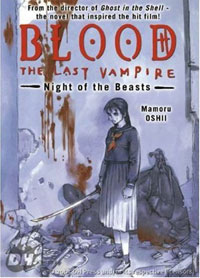
Blood: The Last Vampire: Night of the Beasts (Prose Novel) By Mamoru Oshii Released by Dark Horse
Mamoru Oshii's deductive anti-Yojimbo is the NPR programming of vampire novels. It's not-Kuwabatake Sanjuro is Rei Miwa, a teenager embroiled in the student protest movement of 1969, who runs away from the riot cops and into the scene of a Saya execution. One of the classic characters who seemed like a moth piece for Oshii to voice his concerns was Captain Kiichi Goto of Patlabor. This was a police captain whose sympathies lay with anti-establishment causes. This laid back, nonplussed guy knew everyone and everything, including were the bodies were buried. Escaping formal arrest, escaping Saya, escaping the creature that Saya was hunting, Rei opens his door to find the not-Goto Dective Hajime Gotouda searching his room. It turns out that members of The Proletarian League SR Faction High School Committee have been turning up dead, that their mysterious deaths have been happening soon after Saya transfers into the same school as the dead SR members, that Saya has transferred into Rei's school, and that there is a SR member who is loosely affiliated with Rei's non-partisan group. With Gotouda at his door and Saya at his school, Rei finds himself matching wits with the police, Saya's handlers, and Saya's prey. Part of what is fascinating about Oshii is his own fascinations and Night of the Beasts is quintessentially Oshii. It has his metaphor concerning people who are dogs and people who are wolves. His liberal ideology, coupled with his enthusiasm for the form and accoutrements of authority: the uniforms, the hardware, the weapons. And structurally, it is very Oshii. This is less challenging in prose than it is in cinema. For example, his interest in mentally engaging something makes for structurally compelling movie, but it is better suited for novels. After Hayao Miyazaki's Castle of Cagliostro, Oshii tried to make a Lupin III movie where the exploits of the titular not so gentlemanly gentleman thief, were followed indirectly rather than with the hero center stage. The first Patlabor movie opens with the suicide of its antagonist. The rest of the movie is backtracking who he was and stopping what he left behind. Night of the Beasts is as much about Saya's actions as it is about anything else. However she is hardly present. Instead of stock horror, instead of an extended chase, or even an investigation, Night of the Beasts is a work of forensics; piecing together crime scenes, but also in the broad, not necessarily CSI sense of the word. Besides the point of no return, where student protester, antiauthoritarian Rei discovers that there's a horrific extra-human world lurking out there, the novel has two real teeth to the neck scenes. In the middle, Rei is run off the metaphorical cliff into the middle of a nest of danger; at the end, Rei is again lured onto the scene for the final showdown between the relevant parties. However, a key Oshii factor in Night of the Beast is that the real meat of the novel is a treatise, a Socratic dialog and a debate. First, Rei thinks through the concrete logistics and tactics of protests on the way to a mass demonstration. Then, over Korean barbeque, Rei, Gotouda and his cadre from high school debate a gamut of topics in order to reconstruct the Saya/SR crime scenes. Then Gotouda fights a verbal sparring partner who can match him in terms of ideology, philosophy and knowledge. Here's why this is the meat of the novel. "All right! Now let's apply this knowledge! Say you're a farmer, living in the constant shadow of death, who committed a murder and must dispose of the body. What do you do?" "Bury it." "Burn it." "Weight it down and sink it." "Dissolve it in acid." "Immure it in concrete." "Seal it up behind a wall." "Feed it to the birds." "Feed it to a crocodile." "Feed it to a dog." "Trick a person into eating it." "Eat it yourself." Having finished their bibimbap and kuppa, the boys hungrily piled a huge load of short ribs and roast onto the grill as they shouted their answers." "Apparently, it's easier for you to relate to a depraved farmer than a virtuous one. That's fine. Let's look at each idea individually." And they do in fact look at each idea. This is college dorm room chatter to some extent, but Oshii is an intelligent, informed, and critically, opinionated, writer. Rei serves as an excellent instrument in this discussion. He's sharp, intelligent, and not well read. He's an arrogant rebel who thinks he knows enough about the dynamics of conversation to extricate himself from most verbal traps. This is the intellectual version of the shonen hero: willing to engage in a fight, competent enough to keep it interesting, inexperienced enough to serve as the object to demonstrate the abilities of masters. When the conversation concerns, morbidity and post mortem circumstances, it is interesting to see these vampire-adjacent topics applied to the social ecology of the Japanese student protest movement. When the topic is evolution and the ethics of human/animal relationships, it is interesting to see the ideas applied to a speculative biology version of vampire lore. And yet it builds to a "really?!" moment. "You really want to go THERE Mr Oshii?" The bibliography gives it away Paul Barber's Vampires, Buria and Death Matt Cartmill's A View To Death in Morning: Hunting Through History Peter De Rosa's Vicars of Christ: The Dark Side of the Papacy Sanshirou Yokotama's Rosuchairudo-ka;Yudaya Zaibatsu no Koubou (The Rotschilds; The Rise and Fall of a Jewish International Financial Combine) This is accompanied by a note stating "This story is set in the year 1969. In December 1993, the Vatican and Israel signed a fundamental agreement establishing official peaceful relations. The pattern of that climactic debate is smart, provocative, smart provocative, smart provocative; WTF is that something you really want to perpetuate? Did I just wander into Angel Cop? At least this does translate into an interesting dimension for one of the characters. It’s not terribly dangerous. It's not terribly offensive. It is pretty Da Vinci Code, and after discussions of the theories of Raymond Dart, real philosophy and real theology, conspiracy mongering sticks out as a folly. If you don't care for the philosophical discussions of Oshii's Ghost in the Shell movies, skip Night of the Beasts. What's brilliant about the novel is that is a lecture from one of the great minds of anime. What's dire about the novel is that is one a lecture from one of the great minds of anime. Other than the Rosuchairudo-ka zaibatsu bit, if reading 300 pages of Oshii's sounds enticing, this is a one of kind opportunity. Else, skip it.
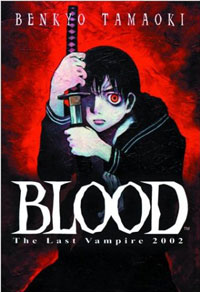
Blood: The Last Vampire 2002 (Graphic Novel) By Benkyo Tamaoki Released by Viz Media
The chief value of Night of the Beasts is that it is a Mamoru Oshii work, available in English. The chief value of 2002 is that it is a Benkyo Tamaoki work, available in English. Blood is a remarkable franchise to house these two starkly different creators. The chance to sample, or experience more of, these distinctive voices is one that shouldn't be missed. Blood: The Last Vampire 2002 is out of print, but it is easy to find a copy online. Manga: The Complete Guide and Secret Comics Japan make the point that Benkyo Tamaoki is an especially mature, mature manga creator. From Secret Comics Japan Most readers of porn manga are male otaku who purchase such manga to use for masturbation. So, in the world of porn manga, if a manga isn't "useful," it doesn't sell. And the more "useful a manga is, the farther it gets from the opportunity to move into a mainstream manga magazine. Tamaoki is one of those rare manga artists who can maintain high levels of artistic quality along with high levels of usefulness. From The Complete Guide's Sex-Philes entry: This is cartoon porn for adults who have actually had sex - it's about adults who want to have sex with each other, and enjoy it, and while the actual sex isn't particularly inventive, the characters' sense of life more than makes up for it. There is a sensual sex scene in 2002, but more than the nipple biting, the context makes it disquieting. Pardon the terrible pun, but 2002 is a biting work. Benkyo Tamaoki teases the boundary between sexual and non-sexual nudity, while making titillation troubling. The first real nudity of the manga is a real buzz-kill: the bound, bleeding "harem and milking farm" of a vampire gang. This is why Benkyo Tamaoki was a subversive choice for the manga. Hide the open veins, dial down the dingy drug den connotations and you get something excitement inducing bondage scenes from Shonen Jump's Ral Grad. Except, here, those elements are unmistakable. Here, with shoulder blades, ribs seen under the skin, some pubic hair and arm pit hair, Benkyo Tamaoki is putting accepted reality and accepted fiction in troublingly close proximity. The bond/gagged, zoned out bleeding being, in this context at least, something out of fiction. The human flesh is acting as an intrusion of reality. One side is contradicting the other. Take out the detailed nudity, and the girls in peril is typical genre manga naughtiness. Take out the genre elements, and the nudity is a straighter version of Benkyo Tamaoki's vision of porn. Like the other Last Vampire stories, matters get messy for Saya. This time she's locked up. In the chapter illustration, the scene has some naughty manga mystique, with chained collar and handcuffs. In the actual story, that bit of wink and nod is removed, courtesy of the image of Saya in a hospital gown, with a bolt lock holding her to a block. Benkyo Tamaoki is literally and figuratively stripping these ideas. Brian Ruh's Stray Dog of Anime: The Films of Mamoru Oshii points out the ambiguity of Saya's design, particularly her school uniform. She's a savage, possibly evil creature in a school uniform that simultaneously suggests innocence and a fetish parody of innocence. As if to react to that ambiguity, Benkyo Tamaoki strips the character bare. There's a scene in which the screeching call of Saya's foe catches her in a flash of echo location. The panel that establishes this is a negative white on black image of a naked Saya. In this and in other scenes, Benkyo Tamaoki seems at war with the glamour of conventional anime/manga figures. He starts from the same place: rail thin bodies with some chest. Then the clothes come off, and the whole range of human implications come to the forefront. This is anti-moe. Benkyo Tamaoki clearly knows that he's working with and recognizes the significance of nudity. One of the manga's final images is a row of naked, shaved adults with number plates hung from their necks, about to be used as test subjects. Beyond that aesthetic dialog, Benkyo Tamaoki's manga is on softer ground in the conceptual department than its Blood compatriots. It's the least political. The doppelganger and biker gang of Benkyo Tamaoki's plot don't transcend the "device" level. The one volume manga concludes with a Saya origin story (that's different than the one in Oshii's novel, that's different than what's suggested in the movie). With little deviation and little insight, the events of the manga never transcend an exercise in genre mix and match. Fundamentally, the manga is structure to collide with the truth of Saya's identity. When that revelation under whelms, it damages the impact of the work as a whole. The real disappointment of the manga is that the origin track crowds out what the manga does well. As overplayed as "teen angst" might be, Benkyo Tamaoki sells the teeth gnashing frustrations. Early, this is almost a slapstick, but acidic joke. Akiko's rebellion is leading her into deeper trouble. At home, her parents and the younger sister that the parents adore have little patience for Akiko's growing pains. At school, the wannabe tough crowd has a real problem with Akiko roaming the streets, projecting an image that they feel isn't sufficiently hard core to be associate with their school. The first Akiko/Saya encounter sees Akiko flung into the air, as a distracting projectile, aimed at Saya. Despite the dismemberment, there is a goofy cartoonishness to Akiko's ass over tea kettle role in the encounter and her improbable El Kabong landing. Later, when Saya is assigned to infiltrate Akiko's high school and get close to the girl, the manga turns farcical with Saya’s graceless attempt to come to the girl's aid. The school's toughs have Akiko cornered and they are about to start lighting her eyebrows and pubic hair on fire when Saya shows up and mercs the crowd. Glaring, sullen looking Saya swinging girls by their ankles, delivering KO elbows to the face and such is pretty hilarious, only to be topped by the send off of Saya grabbing Akiko under her arm, with Akiko pushing her hands up into Saya's cheek, and Saya leaping off the roof. Benkyo Tamaoki is brilliantly able to capture the small details of the absurdity of this routine, and at the same time, darkly echoes the impotence with which Akiko has to live. When she goes home and starts muttering "Dinner ... is awful. I go home ... to my home. Some place I belong... some reason...", and then her sister starts needling her, the manga crackles with teen alienation and injustice. It gets darker and darker, and more demented, but ultimately it is consumed by the Saya story.
Ghibli News
Ghibli World summorizes conversation with Studio Ghibli producer/former head Suzuki Toshio from Cut on the background of Miyazaki Hayao’s new film Gake no ue no Ponyo (Ponyo on a Cliff). The site's news page also relays information from Suzuki Toshio’s radio talk show Ghibli Asemamire. Check these out for talk of artist inspiration, politics, and even Russian lit. According to Nausicaa.net, the Ghibli Asemamire radio show revealed that Isao Takahata's (Pomo Poko, My Neighbors the Yamadas) next film is based on a traditional Japanese lullaby. The intent of a lullaby is to calm a baby but the text can be a polar opposite, Takahata makes this juxtaposition the subject of his next film. NTV (Nippon Television) announced a united campaign titled "NTV Super Anime Summer" for Ponyo and Mamoru Oshii's latest film The Sky Crawlers. The across over is that Sky Crawlers producer Tomohiko Ishii was a member of the production control (management) staff of Studio Ghibli before jumping to Production I.G after Tales of Earthsea. Also in the small world category, Mai, the singer who performs "The rondo of the house of the sunflower" on the Ponyo image album is the daughter of frequent Ghibli movie composer Joe Hisaishi. She had previously sang in Nausicaa as a child.
Gurren Lagann Movie Coming
A Geek By Any Other Name was one of the first to pick up on Tokyo International Anime Fair website's notice that The March 10th issue of Newtype will announce the Tengen Toppa Gurren Lagann movie version. Speculation suggests that this will be a compilation movie.
Maaya Sakamoto to Sing Macross Frontier Opening Theme
Anime News Network reports that voice actress/singer Maaya Sakamoto (Escaflowne) reunite with renowned composer Yoko Kanno will sing "Triangular," the opening song for the upcoming Macross Frontier television series. The flying DOG label will also release the song on a CD single on April 23. The series itself will premiere in April. Macross Frontier's as-yet-untitled ending song will be released on May 8 by a singer under the name "Sheryl Nome," the pseudonym based on the fictional idol singer within the story
Figures News
Organic Hobby, Inc in conjunction with Happinet will be releasing 009-1 “Mylene Hoffman” (Pink Version Limited Edition) in April with a SRP of $102.00. "Mylene Hoffman" the female cyborg is based on the anime series "009-1 (also known as Zero Zero Nine-One)" based off of a manga series, created by famous manga artist Shotaro Ishinomori. "Mylene" is an agent of the all-female "Nine Number Group," one of the ten groups in the "Zero Zero Organization," a Western Bloc intelligence organization. Besides her standard weapon, which is a ray gun, the WA-P009 (commonly called a plasma gun), she also wears earring communicators, boots with a hidden needle gun, and other agent gear. Her most secret pieces of equipment are her 9mm bust machine guns built into both of her breasts, which fires bio-bullets. The figure is 8" tall fully painted and comes in a window box with a custom base for display. To celebrate 70 years anniversary, "Mylene Hoffman (Pink Version Limited Edition)" will be a limited production run of 700 pcs worldwide (no guarantee to fulfill all orders).Organic Hobby, Inc. conjunction with Beagles will be re-releasing limited quantities of their “Motoko Kusanagi” in May with a SRP of $85.00. Major "Motoko Kusanagi" is a fictional Japanese character in Masamune Shirow's Ghost in the Shell anime and manga series. She is a cyborg in the employ of "Public Security Section 9", a fictional division of the real Japanese National Public Safety Commission, as the squad leader. "Motoko Kusanagi" is a 1/7 scale (8 ½" tall) PVC figure and comes in a window box with a custom base for display. Speaking of the Major, Sideshow Collectables are taking preorders for Medicom Toy, Kaiyodo and Perfect-Studio's 1:6 scale Real Action Heroes figures, Motoko Kusanagi. The 12 inch Figure will be released in 2nd Qtr 2008 for $174.99 Kotobukiya sent out their March announcements. Star Wars Tie Fighter Pilot Artfx Statue A KOTOBUKIYA Japanese import srp $ 99.99 11 ¼” tall statue, an assemblable snap-fit kit that can be easily put together in seconds without glue or modeling skill. Available in AUGUST Star Wars: The Bounty Hunter Series A KOTOBUKIYA Japanese import Zuckuss Artfx Statue 10 ¼” tall, in 1/7th scale Zuckuss’ bonus part is: Darth Vader’s Cape; other parts included in the rest of The Bounty Hunter Series: Dengar, Bossk, Boba Fett, IG-88, 4-LOM srp $99.99 Available in AUGUST Indiana Jones: Raiders Of The Lost Art Artfx Theatre A KOTOBUKIYA Japanese import There will be four different Indy Theatres, with one based on each film in the series. The debut release will take us back to 1981 to the film that started it all: RAIDERS OF THE LOST ARK. 12” representation of the Peruvian shrine, and the top shows the infamous podium from the first scene in Raiders. srp $119.99 each Available in JULY Halo 3: Master Chief – Field Of Battle – Artfx Statue A KOTOBUKIYA Japanese import This pvc statue is fully assembled and ready to display out of the box. Master Chief holds two M7 SMGs (Caseless Submachine Guns), or you can switch the bonus arms and have him grip his Assault Rifle. When not using the Rifle, it can be stored on his back. Additional hands are also included for expression, and as a special bonus for fans that collected the first Kotobukiya ARTFX Statue srp $99.99 each Available in AUGUST Devil May Cry 4 Dante Artfx Statue sculpted by Yasuhiro Hirai and Kouei Matsumoto 7 ¾” tall displayed Dante's large Rebellion sword, or his twin pistols: Ebony & Ivory. As a special bonus, this statue is also able to hold the weapons from the other two figures (the sons of Sparda: Dante & Vergil) in Kotobukiya's DMC series srp $79.99 Available in JULY Togainu No Chi (True Blood) Figure & Cd Sets A KOTOBUKIYA Japanese import; Previously sold out – and now available again 1/10th scale yaoi statues. As a special bonus, each figure’s base snaps open to reveal a mini CD inside Akira & Shiki stand approximately 7.5” tall and come in their original Japanese fifth-panel deluxe window box packaging. srp $29.99 each Available now The Art Of Syunya Yamashita Fine Art Busts: Karin and Noel Cold cast porcelain bust series from famed Japanese illustrator Shunya Yamashita Karin Noel Characters in the Art Of Shunya Yamashita series are based on illustrations created exclusively for Kotobukiya, and a reproduction of the original art is included on the collectible packaging. Each bust stands approximately 7 inches tall, including the highly polished podium base. srp $79.99 each Available in JULY SHINING TEARS BLANC NEIGE PVC STATUE A KOTOBUKIYA Japanese import; Based on the PS2 game, and brand new anime series “SHINING TEARS X WIND” , “Ice Witch” BLANC NEIGE Blanc stands 8 2/3” tall (1/8th scale) srp $36.99 Available NOW ZERO NO TSUKAIMA (Familiar of Zero): TABITHA ANIME STATUE A KOTOBUKIYA Japanese import 8” tall (1/8th scale) srp $39.99 Available in JULY SUPER ROBOT TAISEN – FINE SCALE MODEL KITS LOTOBUKIYA Japanese import R-2 POWERED Personal Trooper Type-2 (or simply, the R-2) stands 6 ½” tall (1/144) and comes with a magna beam rifle, a beam Chakram, and two Hi-Zol launchers attached to its back. SRP $27.99 Available in JUNE WILDRAUBTIER 5 2/3” tall / 1/144th scale mech, that can transform into Flight Mode srp $19.99 Available in JUNE MSG MODELLING SUPPORT GOODS MECHANICAL CHAIN BASES 007-010 A KOTOBUKIYA Japanese import The Chain Bases come molded in dark gray, and each has individual accessories. Each base can be easily assembled within minutes and measures 6” long x 6” wide x 6” 1/3 tall upon completion. Each base can be attached in four directions (right, left, top bottom), plus a vertical wall from another set can be mounted onto the top to extend the wall. The bases are perfect for displaying miniature, 1/144 scale, and even 1/100 scale mecha kits and figures! Not just for Koto kits such as Armored Core or Super Robot Taisen, but these bases will work for almost any figure or kit, from Gundam to Evangelion Base 007 includes Crane Arm, and mini mechanic figure Base 008 includes Welding Machine, Catwalk Platform, and mini mechanic figure Base 009 includes Cargo Crane, Catwalk Platform, and mini mechanic figure Base 010 includes Claw machine, Catwalk Platform, and mini mechanic figure srp $13.50 each Available in JULY MSG MODELLING SUPPORT GOODS WEAPON UNITS 08~010 A KOTOBUKIYA Japanese import; Scaled for use with 1/72~1/144 mecha, upgrade your robots with new, original weapons. Each weapon measures approximately 4” long, and requires snap fit assembly, and painting is recommended for customization. Unit MW-08 LANCE & DOUBLE BLADE Unit MW-09 SNIPER RIFLE & NAGINATA (LONG-HANDLED SWORD) Unit MW-010 SHIELD srp $3.99 each Available in JULY ARMORED CORE FINE SCALE MODEL KIT CREST CR-C06U5 - FACINATOR A KOTOBUKIYA Japanese import srp $45.00 Available in JUNE VALKYRIE PROFILE LENNETH VALKYRIE SCULPTURE ARTS STATUE A Square Enix Products Japanese import srp $420.00 17" tall, and is ready to display right out of its original Japanese language package Available in JUNE FINAL FANTASY XII ARTIFACTS JUDGE MASTER GABRANTH HELM REPLICA srp $999.99 1/1 scale prop replica helmet, reproduction of Akihiko Yoshida’s elaborate designs, measuring over 14” high, created from FRP fiber reinforced plastic utilizing the CG data from the game Available in JULY
Jump Collaberations
Canned Dogs reports Jump Square has revealed that there will be one shot collaboration manga by Stan Lee and Takei Hiroyuki (Shaman King) in the first issue of the newly announced Jump Square II that will be released on the 18th of April. The previously announced Katsura Masakazu and Toriyama Akira collaboration manga will have the story done by Toriyama and the art by Katsura.
Blue Dragon on Cartoon Network
VIZ Media has announced that the anime version of Blue Dragon will run on Cartoon Network starting this spring. The BLUE DRAGON series is based on the Xbox 360 videogame “BLUE DRAGON,” developed by Hironobu Sakaguchi, the creator of “Final Fantasy,” and features character designs by Akira Toriyama, the creator of the best-selling DRAGON BALL series of manga (which is published in North America by VIZ Media and featured in SHONEN JUMP Magazine). The animated series debuted in Japan on TV Tokyo on April 7, 2007 and is produced by Studio Pierrot, which is well known for its work on NARUTO and BLEACH, also licensed by VIZ Media.
Anime Aspect to Watchman
A famous part of Alan Moore's Watchmen was the comic-within-a-comic, Tales Of The Black Freighter. According to Empire, Gerard Butler has confirmed that he will be lending his vocal talents to the animated Tales Of The Black Freighter short that Zack Snyder is planning as a companion piece to Watchmen. “I’m going to do the voice of the captain,” said Butler. “They’re going to do it in the style of a Japanese anime and I’m totally stoked."
Princess Knight Revival
Anime News Network reports that Anime scriptwriter Natsuko Takahashi (Gakuen Heaven, Moyashimon: Tales of Agriculture) and manga artist Pink Hanamori (Pichi Pichi Pitch, YumeYume*YouYou) will launch the Sapphire: Ribbon no Kishi (Sapphire: Ribbon Knight or Sapphire: Princess Knight) manga in the May issue (on sale on April 3) of Kodansha's Nakayoshi shojo magazine in Japan. The manga will retell the seminmal shoujo manga from Osamu Tezuka. Princess Knight or Ribon no Kishi was the fairy tale story of Princess Sapphire, a girl who has to undertake the role of a prince.
Upcoming in Japan
From Anime Nation Studio Fantasia, the producers of anime including AIKa, Stratos 4, and Najica, will be creating a new "sexy action" action futuristic mystery anime television series called Crystal Blaze. The anime will be directed by Kase Mitsuko of the SaiKano anime. Matsumoto Pretz' series of Uchi no 3 Shimai ("About Three Sisters") novels, based on the popular Japanese Uchi no 3 Shimai ~Manga de Miru Kyou no Dekigoto~ blog, will premier be adapted into an anime television series scheduled to premier on the TV Tokyo network in April. According to Anime News Network, the Japanese release of Rintaro (Metropolis, X movie)'s CGI animated Yona Yona Penguin has been pushed back to 2009. Screen Daily periodical reported last May that the story is about "a little girl who gets sucked into a fantasy world populated by goblins who believe that their saviour will be a penguin."
3rd Kodansha Morning International Manga Competition Launched
ComiPress reports that Kodansha's 3rd Morning International Manga Competition is accepting submissions through September 30th, 2008. Professional artists are also welcome to this competition. Besides manga, accept all types of comics, including superhero comics, cartoons, and bandes dessine'es and so on are accepted. The grand prize winner will receive $5,000, as well as having their work featured in Morning or Morning 2.
Manga Conclusions
The April 2008 issue of the English version of Shonen Jump will see go manga Hikaru no Go being replaced by basketball manga Takehiko Inoue's (Vagabond) Slam Dunk. The remainder of Hikaru no Go will be released straight to graphic novel collect. Anime News Network reports that Takeshi Konomi's The Prince of Tennis manga and Yoshiyuki Nishi's Muhyo & Roji's Bureau of Supernatural Investigation manga have both ended in this year's 14th issue of Shueisha's Shonen Jump magazine on March 3 in Japan. The Prince of Tennis ran for 379 installments since July of 1999, and the first 40 compiled volumes have sold 40.06 million copies so far. Koge Donbo's (Digi Charat) Kamichama Karin -chu- manga will end in the next issue of Kodansha's Nakayoshi magazine.
New From DrMaster
DrMaster has recently released Chinese Hero: Tales of the Blood Sword volume 5 by Wing Shing Ma, Lunar Legend Tsukihime volume 5 by TYPE-MOON and sasakishonen, and a new series by Yuki Fujisawa, Metro Survive volume 1. Chinese Hero vol. 5Hero defeats Steel Bull and rescues the captured people in Steel Bull Valley. However, before dying, Steel Bull lets out a battle cry, calling a stampede of mad bulls charging into the valley and furiously attacking everyone. The crazed bulls are eventually defeated, but with tragic consequences... While Hero is trying to get back to China Tower, he meets a soothsayer who tells him that he is going to be lonely for the rest of his whole life. Hero sees this as a dark omen of more unfortunate events to come… Meanwhile, China Tower is attacked while Hero is gone, and Zhi, Qin and Ghost Servant fight for their lives as they desperately try to fend off the Black Dragon Gang. Will China Tower be crushed? And will Zhi, Qin and Ghost Servant come out alive? Find out what happens in this action-packed volume of Chinese Hero! Lunar Legend Tsukihime vol. 5 After rescuing Shiki from his dangerous encounter with Roa, Ciel warns him in vain to stay away from Arcueid, who may have an ulterior motive. Meanwhile, Shiki cannot shake off the feeling that he knows Roa, and a visit to the garden of his house jolts his memory, piercing him with visions of Roa as a child, along with a voice telling him that he will become a "true monster" someday. Metro Survive vol. 1 Mishima is your average spineless pushover, working as a repairman for the Exopolis Tower, Tokyo's largest and hottest high-rise business and entertainment building. He promises to come home in time to celebrate his son's birthday, but when he lets his pushy boss saddle him with overtime, the task takes him all night. On the morning subway train heading home, a massive earthquake strikes and collapses both Exopolis and its underground train lines. Now Mishima is trapped deep underground with the other passengers of the train, some of whom are less than cooperative. Will he be able to take the initiative for once and lead them all to freedom, or will they starve in their underground prison? The three titles are available now. Chinese Hero: Tales of the Blood Sword vol. 5 (full color) will be priced at $18.95. Lunar Legend Tsukihime vol. 5 and Metro Survive vol. 1 will each be priced at $9.95.
Worth Checking Out...
Jason Thompson, with Jake Forbes and Ryan Sands present Les Gouttes de Manga Speaking of Thompson, he's contributed to the Comicon magazine Hellsing's Kohta Hirano has illustrated a Smash Bros. doujinshi Canned Dogs look at the Negative Happy Chainsaw Edge manga adaptation by Saiki Junichi, based on the novel by Takimoto Tatsuhiko, also known for his work on the novel Welcome to the NHK!. Via MangaBlog, About.com's Deb Aoki talks to yuri maven Erica Friedman and the editors of the Gothic and Lolita Bible Production I.G talks to director Kenji Kamiyama :: destroy tokyo :: recalls the not-so-classic Iczer One Comics Worth Reading discusses the success found in wrapping up TOKYOPOP's OEL titles here A teaser for the second live action movie based on yokai manga GEGEGE NO KITARO The commercial for the Super Robot Wars spin-off Endless Frontier. It's site has also been updated. Speaking of games, Gunota points out that the official site Gundam Vs. Gundam updated its Gallery section. They also have a Crossover Campaign section detailing different ways to get specially-made Gundam Vs. Gundam items and goods. Gunpla (Gundam plastic model) Jewlry Japanator points out, The Seven Stages of Gaijinhood Scary life sized Haruhi Suzumiya Why the Titania manga should be cool. Search for "Voltron" on the latest Lying in the Gutters comics rumors column. The column also has a red light (warning) rumor concerning why Mecha Manga Bible Heroes isn't listed in Diamond. A preview of upcoming Otaku USA A review of the classic Rose of Versailles Adding Japanese emoticons to your Mac's dropdown menu Cartoon Brew points out the DVD release of Imagination, an experimental indie feature that combines live-action with hand-drawn animation, stop-motion puppet animation, pixilation, and time-lapse.


